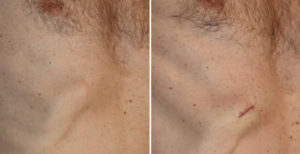Background: The ribs occupy a large amount of one’s torso, encompassing substantial surface area coverage on the chest and back. With twelve pairs of ribs (sometimes one less or more) , these 24 body parts provide structural support and protection for the any organs that keep us alive. While seemingly simple in their design , their location and composition (bone vs cartilage) make for a variety of potential ribcage deformities.
One of the most common areas for such aesthetic deformities is the subcostal rib region. This lower chest area is composed of the merging of the mainly cartilaginous ribs #7, 8 and 9 from the side of the chest into the sternum. When deformities in this area occur, they are especially noticeable but also can cause discomfort in this very palpable area.
The subcostal rib region is prone to deformities particularly from injury. It’s lower margin often sticks out and becomes a prominent target for traumatic events. Because these rib portions are cartilaginous and, more importantly, have an osseo-cartilaginous junction brunt trauma can cause shape deformities. Partial separation of the osseo-cartilaginous junction, subperichondrial hematoma and partial rib cartilage fractures can all make for a prominent subcostal rib protrusion.
Case Study: This middle-aged male developed a very prominent bump along the right subcostal rib margin. It was not present at birth or through the earlier years of his life. It developed without specific recollection of any traumatic event. While he had overall prominent subcostal rib margins due to his very the body frame, there was a very distinct prominent bump on the right subcostal margin along rib #8. It was medial to the osseo-cartilaginous junction.


Highlights:
1) One reason for rib contouring surgery is for prominent and painful rib protrusions.
2) The anterior subcostal ribs margin is a common place for cartilaginous protrusions.
3) Depending on the size of the protrusion, rib shaving reduction is a good technique for its treatment.
Dr. Barry Eppley
Indianapolis, Indiana




